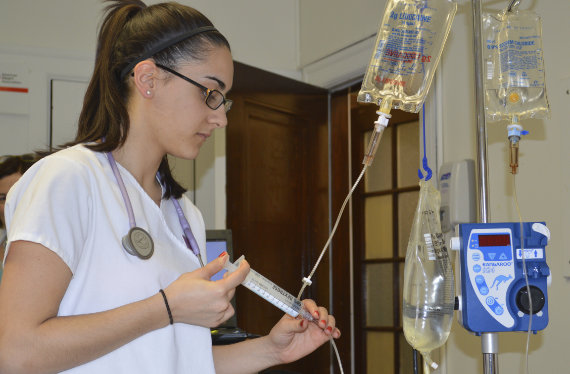If you're a veteran looking to pursue a degree from a college or university, there are several financial options that you can take advantage of to help cover the costs. With this in mind, it’s important to know your options and what will work best for you.
If you are attending a public college or university, the Post-9/11 GI Bill® covers your tuition costs, as long as you are eligible for full coverage. However, if you are considering a private institution the GI Bill® benefits only cover you up to a certain amount. This means that some tuition expenses may be too high for the GI Bill® to completely cover, even if you are eligible for 100% coverage.
The Yellow Ribbon Program is a response to this situation that allows private schools to partner with the federal government to help cover the cost of tuition for veteran students. This article acts as an overview of how private higher education institutions work to provide financial support to student veterans pursuing a degree.
What Is the Yellow Ribbon Program?
While the Post-9/11 GI Bill® covers public college tuition expenses, it does place a cap amount on private school tuition. Not only that, this amount changes every fiscal year. In the federal year 2021, the GI Bill® maxed out at $26,042.81 per academic year. This amount is often insufficient to cover the average cost of private school tuition.
In the 2023–2024 academic year the average cost of tuition for private colleges was $41,540. Keeping the GI Bill® cap number in mind, this leaves a difference of over $14,420. This is the remainder of the tuition that is not covered by the GI Bill®, but is now the responsibility of the student—often referred to as the “gap number.”
The Yellow Ribbon Program is an agreement made between the Department of Veterans Affairs (VA) and the private institution to split the gap number in half. This means that if the school pays up to half of the gap number, the VA will match them. Therefore, eligible students would not likely pay any tuition themselves. This allows veterans to focus on their degree program without worrying about tuition costs.
Yellow Ribbon Schools
Yellow Ribbon schools are voluntary partners with the VA. Since this is a voluntary agreement, it is important to remember that many institutions have flexibility on what and how they offer these benefits.
First, most schools are unable to offer this unique form of financial aid to every student who is eligible. Therefore, many private institutions offer this program on a first-come, first-served basis. Another aspect of this financial aid program that schools can control is the amount of funding. While the idea behind this program was to eliminate the gap number for veteran students, this can only be done if the institution covers half of the amount as the VA will match the university’s contribution. They can take this one step further and even specify what degrees receive aid. For example, a private university may only offer Yellow Ribbon funding to undergraduate and graduate students, but not those at the doctoral level. It’s crucial to know these nuances before pursuing a particular program or school.
Yellow Ribbon Eligibility
Veteran Eligibility
The Yellow Ribbon program is an extension of the Post-9/11 GI Bill® benefits. The key factor that determines your eligibility is that you must also be eligible for 100% GI Bill® benefits. This means that one of the following must be true:
- The applicant must have served for at least 36 months (either consecutive or aggregate) active duty since September 11, 2001.
- The applicant must have served at least 30 consecutive days since September 11, 2001 and been discharged honorably for a service-connected disability.
Therefore, if you are only eligible for 90% or less of the GI Bill®'s education benefits, you do not qualify for the Yellow Ribbon Program.
Dependent Eligibility
If you want to use your VA benefits toward your children's college education, you may be able to do so through the Yellow Ribbon Program. Eligible veterans may allocate funds to their dependent children—provided they are eligible for 100% GI Bill® coverage. Dependents eligible for the transfer of entitlement under the Post-9/11 GI Bill® may also qualify for the program.
Maintaining Your Yellow Ribbon Benefits
Even if you are accepted into the Yellow Ribbon Program, that does not mean that you are automatically covered for the remainder of your time as an enrolled student. In order to remain covered under the program, these four factors must remain consistent:
- The school must continue to offer the Yellow Ribbon Program to eligible students.
- You must be making satisfactory progress toward the completion of your degree program.
- In accordance with the school's policy, you must remain continuously enrolled at the college or university.
- You must continue to be entitled to receive full GI Bill® benefits.
If you decide to transfer to another school, your coverage under the Yellow Ribbon Program is dependent on the school you switch to. Make sure that your new school participates in the program and what you need to reapply in order to continue to receive benefits.
How to Find a Yellow Ribbon School
If you're not sure how to go about finding a school that offers Yellow Ribbon benefits, don’t worry! It is a fairly easy process.
1. Look at the Institution's Website
Colleges will often have a veteran's page or information section on their website informing veteran students of the benefits available to them. This information will show you the specific coverage that the school offers.
2. Use the VA's Yellow Ribbon School Finder
The VA offers an online tool that helps you find Yellow Ribbon schools, as well as the specific amount of coverage each school provides under the program. This tool allows you to review the most important aspects of this research:
- The maximum amount of funding that is available per student, per year
- The degree type that is covered
- How many students are eligible to receive the benefit
- The school or program that is covered
Remember that if the college or university you are interested in is public, they will not offer the Yellow Ribbon program as the GI Bill® will not max out at a certain tuition level. But if you are seeking enrollment at a private school, the Yellow Ribbon Program is an excellent option for you to look into.
Apply Early
If your school offers the Yellow Ribbon Program and the GI Bill® benefits aren’t enough to cover the cost of your college education, it is important to be proactive. Schools typically offer Yellow Ribbon benefits on a first-come, first-served basis. Apply early and ensure that you are able to eliminate your tuition expenses
GI Bill® is a registered trademark of the U.S. Department of Veterans Affairs (VA). More information about education benefits offered by VA is available at the official U.S. government website.





